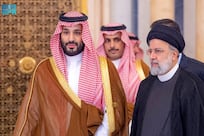The editors of The New York Times, one of the most pro-Israel publications in the United States, are exasperated with Tel Aviv. In an editorial last week headlined At the Boiling Point With Israel, the editors described how the Israeli government has made peace with the Palestinians nearly impossible with the continued creation of settlements on the West Bank. Days after Israel's former president and "peacemaker" Shimon Peres was buried in Jerusalem, prime minister Benjamin Netanyahu announced another settlement to be built on land earmarked for a Palestinian state. A fitting memorial to Peres's memory.
The editors believe that pressure, in the form of US support for a United Nations Security Council resolution against Israel, is needed to send a message to Tel Aviv. While the idea might sound compelling (and is hardly new), it will certainly fall on deaf ears, as Israel has just received an aid package from Washington valued at $38 billion (Dh139 billion), the largest amount of aid the US has ever given a foreign country.
The framework and language of peace, which The New York Times bemoaned and most in the West take for granted, is rooted in the 1993 Oslo Accords. The interim agreement was designed to be a blueprint for Palestinian statehood, and hinged on a slow transfer of power from the occupier to the occupied. The West Bank was carved up into three zones of autonomy: one in which Israel maintained total control, one in which control was split between Israel and the Palestinian Authority, and one in which the PA was in control. The same was true for the Gaza Strip.
This framework, which left final status issues such as Jerusalem and the return of Palestinian refugees off the table, made some sense at the time. But in practice, Israel never gave up total military control of the territory, but rather expanded its settlement project in the West Bank and stifled Palestinian economic growth with the creation of complex foreign aid packages that gave outside countries outsize control over the Palestinian purse strings. When the Second Intifada broke out in 2000, Israel was able to “reoccupy” with ease because it never really stopped occupying in the first place.
Palestinian state institutions were a critical ingredient for the success of the Oslo Accords. Without a functioning state architecture, how was the PA, a governing body created by Oslo, supposed to transform into a functioning state? Aside from the security services, which were trained by Israel and the US in Jordan, Palestinian businessmen invested significant amounts of money in the West Bank and Gaza during the 1990s in the hopes that statehood was on the horizon. Munib Al Masri, a businessman from Nablus, is an example of those who made a fortune in telecoms, construction, tourism, energy, banking and agriculture.
During this brief “peace” period in the 1990s, the Palestine Stock Exchange (PSE) was founded in the northern West Bank city of Nablus. After initial investments from Palestinians, Jordanians and Saudis, the PSE was hit by the Second Intifada. To cope with the closures and curfews that were common in Nablus during the fighting, the PSE moved to an all-electronic trading model.
Today the stock exchange has a market value of $3.3 billion and trades 15 stocks that include industrial and real estate holding companies, banks, telecoms and drugmakers. Palestine Telecommunications and the Bank of Palestine are the two largest companies traded.
Unlike most crumbling institutions in Palestine, the PSE was just incorporated into the FTSE Russell index of 27 frontier markets in September. And although Palestine is synonymous with risk for most in the West, Bloomberg has reported that the PSE index has risen 10 per cent over the past year. This is incredible given that the Palestinian economy is hamstrung by a lack of water resources, national sovereignty, open borders and air and seaports.
The inclusion of the PSE to the FTSE frontier index could bring more capital into the market that would enable Palestinian companies on the index to be given frontier status. Independent investment into the economy, as opposed to state-sponsored investment and foreign aid, brings with it the real promise of transformation.
A large part of Oslo’s failure was leaving Palestinian institutions at the mercy of international aid. When Mahmoud Abbas, the only surviving member of the four Israeli and Palestinian leaders who signed the Oslo Accords, went to the UN to pursue statehood in 2011, the Palestinian Authority was punished with the withholding of aid by Israel and the United States. Thousands of Palestinian civil service employees went months without their full salaries, and state projects were severely curtailed (excluding security cooperation with Israel). The message from the international community to the PA was clear: don’t step out of line and pursue independence unilaterally.
The prospect of direct investment, free from the constraints of Tel Aviv and Washington’s whims, has the potential to transform the power imbalance on the ground. The more Palestinians are able to wean themselves off international aid and donor support, the better positioned they are to take aggressive action against Israel in world bodies such as the UN. Few are under an illusion that the Palestine Stock Exchange will be the only vehicle for achieving Palestinian independence, but it is a start.
jdana@thenational.ae
On Twitter: @ibnezra





